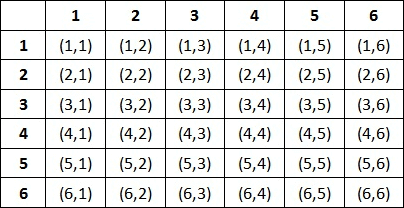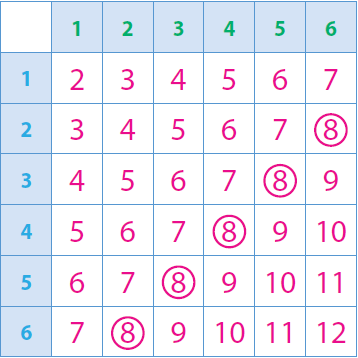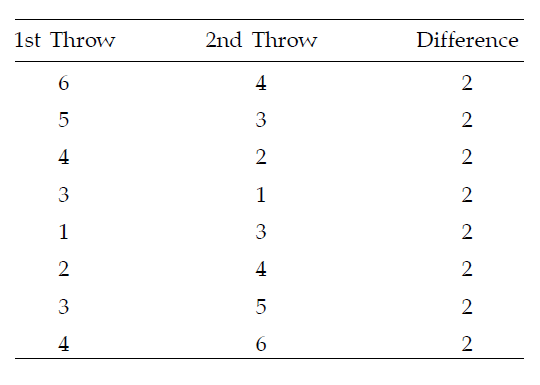FINDING PROBABILITY USING A TABLE
Recall that a compound event consists of two or more simple events.
To find the probability of a compound event, we have to write a ratio of the number of ways the compound event can happen to the total number of equally likely possible outcomes.
Examples
Example 1 :
Jacob rolls two fair number cubes. Find the probability that the sum of the numbers he rolls is 8.
Solution :
Step 1 :
List out all the possible outcomes when two cubes are rolled.

There are 36 possible outcomes in the sample space.
Step 2 :
Create a table where each cell represents the sum on two number cubes.
Then, circle the outcomes that give the sum of 8.

Step 3 :
Find the number of outcomes in which the sum is 8.
Number of outcomes in which the sum is 8 = 5
Step 4 :
Find the required probability.
P (for sum 8) = 5 / 36
So, the probability that the sum of the numbers is 8 is 5/36.
Example 2 :
A six faced number cube is rolled twice. What is the probability of getting a difference of 2 ?.
Solution :
Step 1 :
List out all the possible outcomes when two cubes are rolled.

There are 36 possible outcomes in the sample space.
Step 2 :
List out the outcomes where the difference between two numbers is 2.

Step 3 :
Find the number of outcomes in which the difference is 2.
Number of outcomes in which the difference is 2 = 8
Step 4 :
Find the required probability.
P (for difference 2) = 8 / 36
P (for difference 2) = 2 / 9
So, the probability of getting a difference of 2 is 2/9.
Example 3 :
Two dice are thrown simultaneously. Find the probability that the sum of points on the two dice would be 7 or more.
Solution :
If two dice are thrown then, as explained in the last problem, total no. of all possible outcomes is 36.
Now a total of 7 or more i.e. 7 or 8 or 9 or 10 or 11 or 12 can occur only in the following combinations :
Sum = 7 -----> (1, 6), (2, 5), (3, 4), (4, 3), (5, 2), (6, 1)
Sum = 8 -----> (2, 6), (3, 5), (4, 4), (5, 3), (6, 2)
Sum = 9 -----> (3, 6), (4, 5), (5, 4), (6, 3)
Sum = 10 -----> ((4, 6), (5, 5), (6, 4)
Sum = 11 -----> (5, 6), (6, 5)
Sum = 12 -----> (6, 6)
Thus the no. of favorable outcomes is 21.
Let A be the event of getting a total of 7 points or more.
Then,
P(A) = 21/36
P(A) = 7/12
Kindly mail your feedback to v4formath@gmail.com
We always appreciate your feedback.
©All rights reserved. onlinemath4all.com
Recent Articles
-
Digital SAT Math Problems and Solutions (Part - 146)
Apr 18, 25 06:52 AM
Digital SAT Math Problems and Solutions (Part - 146) -
Logarithmic Derivative Problems and Solutions
Apr 16, 25 09:25 PM
Logarithmic Derivative Problems and Solutions -
Digital SAT Math Problems and Solutions (Part - 145)
Apr 16, 25 12:35 PM
Digital SAT Math Problems and Solutions (Part - 145)

